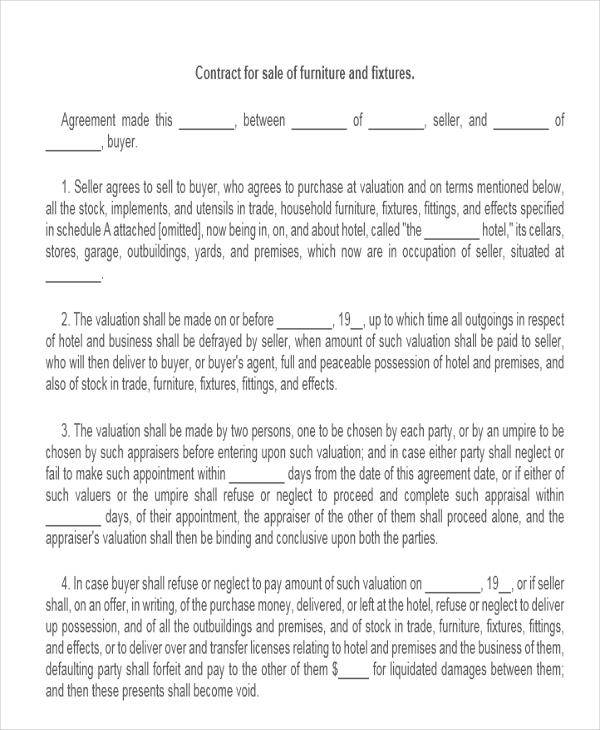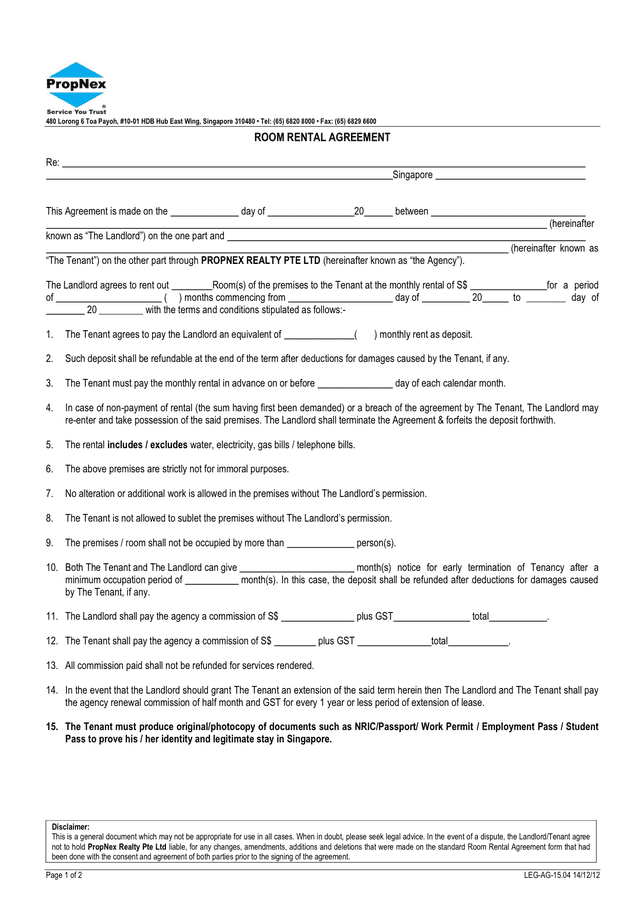Imagine this: you’re selling your business. You’ve negotiated the price for the building, the land, and the equipment. Everything seems settled, you’re ready to sign on the dotted line. But then, a question pops up: “What about the furniture and fixtures?” You might think, “It’s just furniture, it’s not that big a deal.” But believe me, it can be a major headache if you don’t handle it carefully.

Image: www.sampletemplates.com
That’s where a separate agreement for the sale of furniture and fixtures comes in. This seemingly simple document can save you a lot of stress and potential legal battles down the road. This agreement clarifies exactly what furniture and fixtures are included in the sale, their condition, and the purchase price. In this article, we’ll delve into the world of separate agreements for furniture and fixtures, explaining why they are crucial, what they should include, and how to navigate this aspect of the business sale process.
Why a Separate Agreement for Furniture and Fixtures is Essential
When selling a business, the focus often centers around large assets like real estate, equipment, and inventory. Yet, furniture and fixtures, though seemingly minor, are essential for a business’s functionality and often represent a significant investment. A separate agreement ensures clarity and avoids disputes regarding these assets.
Here are some compelling reasons why a separate agreement is crucial:
- Clear Definition of Assets: The agreement details exactly what furniture and fixtures are included in the sale. This prevents misunderstandings and disputes over what’s included and what’s excluded.
- Accurate Valuation: It establishes a fair and agreed-upon price for the furniture and fixtures. This prevents later disagreements about their value.
- Condition and Wear and Tear: The agreement can specify the condition of the furniture and fixtures. If there are any defects or wear and tear, they are documented right from the start.
- Transfer of Ownership: The agreement makes it clear who owns the furniture and fixtures after the sale, transferring ownership from the seller to the buyer.
- Avoiding Legal Disputes: By addressing these details upfront, you significantly reduce the chances of legal disputes later on.
- Peace of Mind: Having a separate agreement offers peace of mind to both the seller and the buyer, ensuring a smooth transition of ownership for these crucial assets.
What Should a Separate Agreement Include?
A robust agreement that adequately protects both seller and buyer should include the following key elements:
- Identification of Furniture and Fixtures: List each item included in the sale in detail. This can include tables, chairs, desks, shelves, lighting fixtures, display cases, and any other related items.
- Description of Condition: Document the condition of each item, mentioning any defects, wear and tear, or damage present. This should be clear and accurate to avoid future disputes.
- Purchase Price: Clearly state the agreed-upon price for the furniture and fixtures. This price should be reflected in the overall transaction documentation.
- Transfer of Ownership: Specify the date and method of transferring ownership from the seller to the buyer. This could involve signing over the title or other necessary documents.
- Warranty and Disclaimer: Include any warranties provided by the seller regarding the condition of the furniture and fixtures. In addition, clearly state any disclaimers that pertain to the furniture, outlining what is not covered by the agreement.
- Payment Terms: Specify payment terms, including the payment amount, payment schedule, and payment methods.
- Inspection and Acceptance: Include a clause requiring the buyer to inspect the furniture and fixtures before purchasing them and to accept them in their current condition.
- Removal of Furniture and Fixtures: Clarify the time frame and processes for the buyer to remove the furniture and fixtures from the premises.
- Legal Representation: It’s highly recommended to consult with an attorney who specializes in business transactions to ensure the agreement meets all legal requirements and adequately protects your interests.
Negotiating the Agreement
Negotiating the sale of furniture and fixtures, especially when they hold sentimental value or represent a significant investment, requires careful consideration. Take the time to:
- Inventory and Assess Value: Create a comprehensive list of all furniture and fixtures you are selling. Then, research fair market values to ensure you are asking a reasonable price.
- Communicate Clearly with Buyer: Openly discuss the condition of the furniture and fixtures and any potential issues with the buyer.
- Be Flexible: Be willing to negotiate on the price and payment terms. Keep an open mind to accommodate the buyer’s needs and desires.
- Consider Options for Removal: Discuss transportation and removal options with the buyer. Be willing to assist with the process if feasible.
- Documentation and Legal Review: Properly document the terms of the agreement and ensure all parties involved understand the agreement’s details. Consult with an attorney to review the agreement before signing.

Image: www.dexform.com
Expert Insights and Actionable Tips
Expert Insight: “A separate agreement is like the foundation of a house,” says Samantha Jones, a seasoned business lawyer. “It lays the groundwork for a smooth and hassle-free transition of ownership. Don’t underestimate the value of a clear and well-drafted agreement.”
Actionable Tips:
- Don’t Overlook the Details: Even if the furniture seems insignificant, it’s crucial to document each item with its condition and value.
- Set Realistic Expectations: Be prepared to negotiate. Don’t be afraid to say “no” if the buyer’s offer isn’t fair.
- Seek Professional Assistance: Contact a lawyer specialized in business transactions to guide you through the legal intricacies of the process.
Separate Agreement For Sale Of Furniture And Fixtures
Conclusion
A separate agreement for the sale of furniture and fixtures is often an overlooked but critical component of any business sale. By clearly documenting the specific assets, their condition, and the purchase price, you can avoid misunderstandings, prevent legal disputes, and ensure a smooth transition of ownership. While it might seem like a minor detail, this agreement is a powerful tool that can safeguard your business interests and secure a positive outcome for both parties involved.
Remember, open communication, thorough documentation, and legal counsel are vital for a successful sale of furniture and fixtures. Don’t leave it to chance, take proactive steps to protect your interests!






